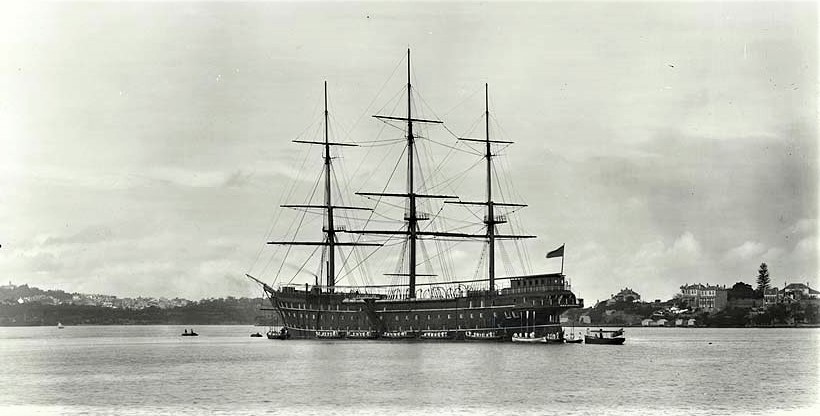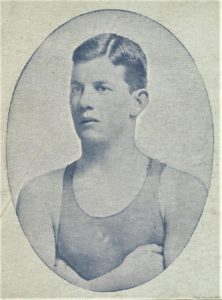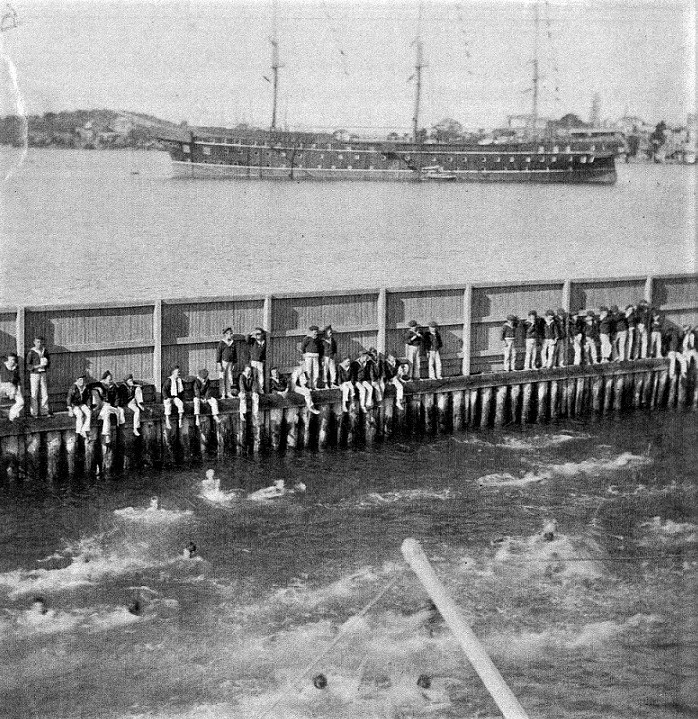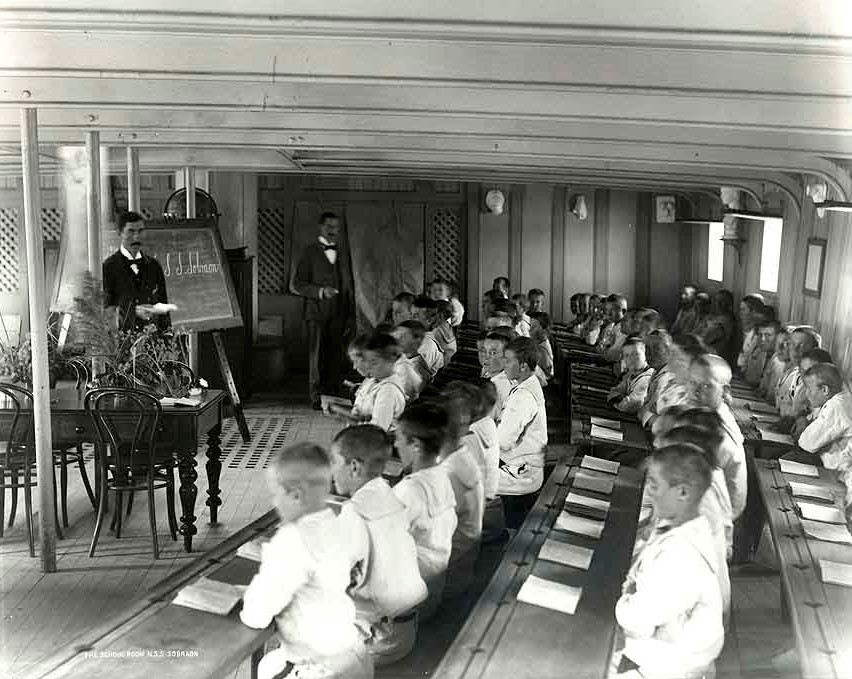By Lorraine Fildes
HMAS Tingira was commissioned on 25 April 1912 to provide early naval training for young recruits to the Navy. The Tingira was originally called the Sobraon and what I am going to look at in this article is the training that was carried out on the Sobraon and some of the remarkable achievements of the Sobraon boys, especially one boy in particular, Bernard Kieran.

Sobraon was one of the fastest and largest sailing ships ever built in 1866. It traded between England and Australia from 1866 until 1891. She was sold to the New South Wales Government in December 1891 as a reformatory ship to replace the existing one – Vernon. Sobraon lay at anchor in Sydney harbour for the next twenty years performing this duty.
Boys who were 16 years or younger could be detained and admitted to a reformatory school if they had engaged in ‘at risk’ behaviour – for example, begging, loitering, sleeping in the open air, and having no lawful accommodation.
Now to introduce Bernard Kieran – Bernard Bede (Barney) Kieran (6 October 1886 – 22 December 1905). He spent several years attached to Sobraon, starting in March 1900 when he was thirteen years old. He came to be aboard the ship because his mother stated that the boy will not go to school, that he stops out at night and that she has no control over him. After being committed by the Water Police Court on 1 March 1900 Barney was sent to the Sobraon.

The boys on board Sobraon had a strict, disciplinary life under the careful control of Superintendent Frederick William Neitenstein. Apart from being disciplined, the boys benefited from structured education with qualified teachers and trainers aboard a well-appointed vessel. They received a general education and were taught nautical skills and trades. The boys also enjoyed activities such as swimming, gardening, rowing, and music. They formed a band that was in much demand on many an important ceremonial occasion, and such was the standard of their tuition and development that some of the lads found positions in orchestras. Some of the boys attained acclaim, both at home in Australia and overseas, in the field of sport as well as music. Bernard Kieran obtained worldwide fame as a swimmer.
Kieran’s formative years were spent literally surrounded by water as a cadet on the training ship Sobraon. He was at first self-taught, ‘training’ by diving overboard and swimming casually around Sydney Harbour. He also watched swimming races that were held in the Fitzroy Dock – 157 yds long and he used the Sutherland Dock for his swimming training which was 246 yds long.
Kieran’s brilliant swimming career took off in 1904 when swimming for the Sobraon Club. He showed such speed that he was matched with the great Australian swimmer Richard ‘Dick’ Cavill over the 220yds. Cavill, then the world’s leading swimmer, won by a touch. The pair met again later that year over 880yds and Kieran won. The former Australian champion Robert Robertson Craig stepped forward to coach Kieran.
Bernard Kieran is one of the forgotten, outstanding and tragic figures of early Australian swimming history; one of a group of champions who established Australia in the early days of the century as a notable nation in swimming. At the peak of his career (which spanned less than two years), Kieran was unchallenged as the fastest swimmer in the world over all distances from 220yds to the mile.
At the beginning of 1905 Bernard was invited to England by the (Royal) Life-Saving Society to compete in the King’s Cup. A special farewell concert for Kieran was held in April 1905.
Hilton Mitchell accompanied and managed Kieran on the swimming tour in the United Kingdom and Sweden. Kieran arrived in London on 17 June. After months on a ship and out of shape, the 18 year old Australian started competition swimming. On 26 June at the Bath Club, Piccadilly, London ‘the Sobraon Boy’ began his sensational record-breaking tour by easily lowering the record time for 600 yards in an exhibition swim.

In August Kieran beat the world famous English swimming champion David Billington in the 440 yards salt-water and 880 yards freestyle titles, the latter in the world record time of 11 minutes, 28 seconds. At an international meeting in Sweden he won four events and set a world record for 500 yards. In September he won the 220 yards title and his third English record medal, for the 300 yards. His modesty and sportsmanship won him many admirers and on his return to Australia in November 1905 he was accorded a hero’s welcome.
In December he competed in Brisbane and won the Australian 220, 440 and 880 yard titles. He became ill on the third day of the titles and was rushed to hospital almost immediately after winning the 880 yard race. He had acute appendicitis, was operated on, but died three days later aged only 19.
Kieran was described at one point by the Brisbane Courier newspaper as the world’s greatest swimmer. During the course of his swimming career, he earned a number of trophies. The trophies comprise three cups, 26 gold, 8 silver, and two bronze medals, won over all distances, from 220 yards to a mile. Kieran’s numerous medals and trophies were acquired by the New South Wales Government and he is commemorated by the Kieran memorial shield awarded annually to the champion State in the Australian championships.
In 1969 he was honoured by the International Swimming Hall of Fame at Fort Lauderdale, Florida, United States of America.
Not until the early 1920s, did swimmers anywhere in the world approach Kieran’s times in an era when few knew anything about conditioning and training. Sports medicine was unknown.
There was a special swimming carnival held at Drummoyne Baths on Wednesday 24th January 1906 to raise money for The Kieran Memorial Fund. Over £306 was collected, and it was expended on a number of items: Tombstone and grave, memorial shields, medical and funeral expenses, and the balance was expended on medals, to be competed for by school boys for the next 10 years.
The inscription on the tombstone reads:
Erected by the public as a tribute to the late Champion Swimmer of the World. He won his laurels by courage, self-denial, and patient effort. His achievements and manly qualities will long be remembered in this, and other countries in which his victories were gained.

References:
NSW State Archives: Bernard Bede (Barney) Kieran, Swimmer (nsw.gov.au)
Wikipedia: Bernard Kieran – Wikipedia
Tingira Australia Association: https://tingira.org.au/history/
Sydney Harbour Federation Trust: http://www.cockatooisland.gov.au/en/our-story/industrial-schools/
Australian Dictionary of Biography: https://adb.anu.edu.au/biography/kieran-bernard-bede-6951
Monuments Australia: https://monumentaustralia.org.au/themes/people/sport/display/21323-bernard-kieran






